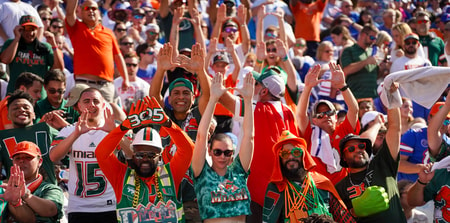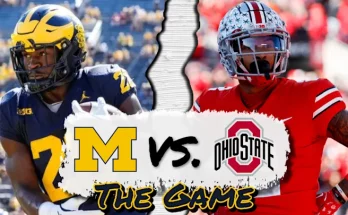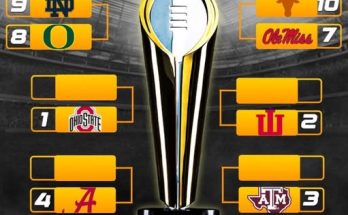After a roller-coaster 2024 season marked by flashes of brilliance and stretches of inconsistency, the Miami Hurricanes are once again facing the same fundamental question heading into 2025: Can they find the kind of offensive firepower that allows them to average 35 or more points per game? In a landscape where high-scoring offenses often separate the contenders from the pretenders, Miami’s hopes of reclaiming national relevance rest heavily on whether their offense can light up the scoreboard with the regularity that their fanbase craves and their recruiting base demands. In the ACC’s evolving battleground and with the College Football Playoff expanding, scoring points isn’t just a luxury—it’s a necessity.
Last season, the Hurricanes ended the year averaging just under 30 points per game, good enough for the middle of the pack nationally but far from elite. That number, however, tells only part of the story. Against lesser opponents, Miami was able to feast—dropping 48 against Bethune-Cookman and 38 on Georgia Tech. But when the lights were brightest and the competition toughest, their offense fizzled. In losses to Florida State and Louisville, Miami failed to reach the 25-point mark, leaving fans with the all-too-familiar sense that while the Hurricanes could look the part on paper, they still hadn’t found the recipe to cook with fire every Saturday.
The core of the offensive struggle came down to inconsistency at quarterback and an identity crisis in offensive philosophy. Tyler Van Dyke, once heralded as the next great Miami signal-caller, never fully rediscovered the rhythm that made him a breakout star in 2021. His injury woes and lack of cohesion with the receiving corps led to turnovers, stalled drives, and a general sense that Miami’s offense was more reactive than proactive. And while the offensive line took strides forward under new coaching in 2024, protection breakdowns at key moments undermined long-developing plays and hamstrung any hope of sustained tempo.
Yet, there are reasons to believe that the script could flip in 2025. The most immediate source of optimism is the talent infusion set to hit the field in Coral Gables. The Hurricanes bring in one of the more dynamic recruiting classes in the ACC, headlined by five-star quarterback prospect Antoine Jackson. Jackson has the mobility, arm strength, and football IQ that Miami has lacked since the early days of D’Eriq King, and the coaching staff is hopeful that with a full spring and summer under his belt, Jackson could push for immediate playing time—or at the very least, elevate the competition room enough to force better play across the board.
In addition to Jackson, Miami’s offensive skill position room is getting a much-needed boost. Wideout Jeremiah Smith’s transfer from Ohio State to Miami is one of the most talked-about moves of the offseason, and it’s not hard to see why. Smith is a route technician with elite hands and a 6’3” frame that makes him a red-zone nightmare. Paired with junior Xavier Restrepo—one of the few consistent bright spots from 2024—Miami suddenly has a legitimate 1-2 punch on the outside. Restrepo’s grit and ability to find soft spots in zone defenses will be the perfect complement to Smith’s explosive outside threat.
The running game, which has been respectable but not dominant, also gets a boost with the return of Henry Parrish Jr. and the expected breakout of sophomore Tre’Von Mincey, whose electric speed and vision made him a fan favorite in limited action last season. If the offensive line—led by returning starters Jalen Rivers and Francis Mauigoa—can continue their upward trend, Miami may finally have the balanced attack that has eluded them in recent years.
Offensive coordinator Shannon Dawson also enters his second year in Miami with a clearer understanding of what works and what doesn’t within his system and roster. Dawson’s Air Raid background gives the Hurricanes a system designed to stretch defenses horizontally and vertically, but it’s a scheme that requires rhythm, quick decision-making, and chemistry between quarterback and receivers. Those were missing ingredients in 2024. But with more experience in the system and better personnel to execute it, 2025 could be the season the playbook opens up in a meaningful way.
There’s also the intangible factor: hunger. Miami, for all its bravado and tradition, has not been a truly feared offensive team in over a decade. The days of Ken Dorsey, Willis McGahee, and Andre Johnson lighting up defenses feel like ancient history to many younger Canes fans. This current generation of players is well aware of the program’s history—and they’ve grown weary of merely being compared to the past. Multiple players and coaches have emphasized this offseason that the goal isn’t just improvement, but domination. That means putting up points in bunches and burying teams early—something Miami has struggled with even in its wins.
However, even with the right personnel and mindset, there’s still the matter of execution. Miami’s red zone offense was among the most frustrating aspects of 2024, as too many promising drives ended with field goals or turnovers. Dawson has made red zone efficiency a focal point in offseason install sessions, and the team has reportedly emphasized situational football during summer workouts. Success in 2025 will hinge not just on racking up yardage, but turning those yards into six points instead of three.
The schedule will give the Hurricanes a chance to test their offensive mettle early and often. Opening against a Group of Five opponent gives them the opportunity to fine-tune things before facing a challenging non-conference matchup with Florida, followed by an ACC slate that includes tough defenses like Clemson, NC State, and Florida State. If Miami is serious about chasing 35+ points per game, it won’t come by beating up on cupcakes alone—they’ll need to move the ball against the conference’s best, particularly in crunch time.
Another key storyline is the development of the tight end position, which has historically been a strength at Miami. In 2024, the tight end room was quiet, largely due to injuries and schematic shifts. But redshirt sophomore Riley Williams is poised for a bigger role in 2025. At 6’6” with excellent body control and hands, Williams could become a safety valve and mismatch nightmare if used properly. His presence in two-tight end sets also opens up possibilities for creative play-action designs and gives the quarterback another big target in the red zone.
Ultimately, the Hurricanes’ pursuit of a 35-point-per-game offense is not just about putting up flashy numbers—it’s about signaling a return to relevance. In today’s college football world, explosive offenses are what draw recruits, fill stadiums, and keep programs in the national conversation. Miami has lived in the shadow of its own expectations for too long. It’s time to see whether this coaching staff, this group of players, and this offensive philosophy can finally deliver on the promise that seems to surround the program every preseason.
The blueprint is there. The talent is arriving. The schedule offers opportunities. But the question remains whether the Hurricanes can put it all together when it counts. If they do—if they can crack the 35-point ceiling consistently—then 2025 could mark the beginning of a new era in Coral Gables, one where the U isn’t just back in hashtags and hype videos, but in wins, rankings, and relevance.
Miami doesn’t need to be perfect offensively. But they do need to be dangerous. In a conference where Clemson’s dominance is no longer guaranteed and Florida State has reasserted itself as a national power, the door is open for a new challenger. With a dynamic quarterback, improved skill players, and a refined offensive system, Miami has the tools to storm through it. Whether they will—or whether they’ll once again leave fans wondering what could have been—will be revealed one drive at a time.



